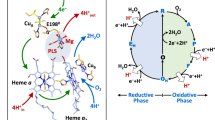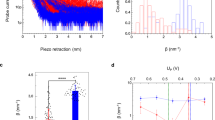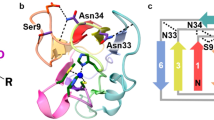Abstract
Cytochrome c can be modified by [(NH3)5RuII/III-] specifically at the imidazole moiety of histidine 33, and we have recently discussed the thermodynamics and kinetics of electron transfer within this modified protein1–5. X-ray crystal structures of the oxidized and reduced forms of tuna cytochrome c6 indicate that the separation between the haem group of cytochrome c and the ruthenium label is 12–16 Å. Internal electron transfer from the [(NH3)5RuII-] centre to the Fe(III) haem centre occurs with a rate constant K ≃ 53s−1 (25 °C) (ΔH‡=3.5kcal mol−1, ΔS‡ = −39EU), as measured by pulse radiolysis. The measured unimolecular rate constant1, k ≃ 53 s−1, is on the same timescale as a number of conformational changes that occur within the cytochrome c molecule7–9. These results raise the question of whether electron transfer or protein conformational change is the rate limiting step in this process. We describe here an experiment that probes this intramolecular electron transfer step further. It involves reversing the direction of electron transfer by changing the redox potential of the ruthenium label. Electron transfer in the new ruthenium–cytochrome c derivative described here is from haem(II) to the RU(III) label, whereas in (NH3)5Ru–cytochrome c the electron transfer is from RU(II) to haem(III). Intramolecular electron transfer from haem(II) to RU(III) in the new ruthenium–cytochrome c described here proceeds much slower (> 105 times) than the electron transfer from Ru(II) to haem(III) in the (NH3)5Ru–cytochrome c. We therefore conclude that electron transfer in cytochrome c is directional, with the protein envelope presumably involved in this directionality.
This is a preview of subscription content, access via your institution
Access options
Subscribe to this journal
Receive 51 print issues and online access
$199.00 per year
only $3.90 per issue
Buy this article
- Purchase on Springer Link
- Instant access to full article PDF
Prices may be subject to local taxes which are calculated during checkout
Similar content being viewed by others
References
Isied, S. S., Kuehn, C. & Worosila, G. J. Am. chem. Soc. 106, 1722–1726 (1984).
Isied, S. S., Worosila, G. & Atherton, S. J. J. Am. chem. Soc. 104, 7659–7661 (1982).
Yocum, K. et al. Proc. natn. Acad. Sci. U.S.A. 91, 7052–7055 (1982).
Nocera, D. G., Winkler, J. R., Yocum, K. M., Bordignon, E. & Gray, H. B. J. Am. chem. Soc. 106, 5145–5150 (1984).
Yocum, K., Winkler, J. R., Nocera, D. G., Bordignon, E. & Gray, H. B. Chemica Scr. 21, 29–33 (1983).
Takano, T. & Dickerson, R. E. J. molec. Biol. 153, 95–115 (1981).
Creutz, C. & Sutin, N. Proc. natn. Acad. Sci. U.S.A. 70, 1701–1703 (1973).
Creutz, C. & Sutin, N. J. biol. Chem. 249, 6788–6795 (1974).
Moore, G. et al. Discuss. Faraday Soc. 74, 311–379 (1982).
Zwickel, A. M. & Creutz, C. Inorg. Chem. 10, 2395–2399 (1971).
Wherland, S. & Gray, H. B. in Biological Aspects of Inorganic Chemistry (eds Addison, A. W., Cullen, W. R., Dolphin, D. & James, B. R.) 289–368 (Wiley, New York, 1977).
Isied, S. S. & Taube, H. Inorg. Chem. 15, 3070–3075 (1976).
Tabushi, I., Yamamura, K. & Nishiya, T. J. Am. chem. Soc. 101, 2785–2787 (1979).
Tabushi, I., Yamamura, K. & Nishiya, T. Tetrahedron Lett. 49, 4921–4924 (1978).
Bosshard, H. R. & Zürrer, M. J. biol. Chem. 255, 6694–6699 (1980).
Rackovsky, S. & Goldstein, D. A. Proc. natn. Acad. Sci. U.S.A. 81, 5901–5905 (1984).
Williams, G., Clayden, N. J., Moore, G. R. & Williams, R. J. P. J. molec. Biol. 183, 447–460 (1985).
Margoliash, E. & Schejter, A. Adv. Protein Chem. 21, 113–286 (1966).
Author information
Authors and Affiliations
Rights and permissions
About this article
Cite this article
Bechtold, R., Kuehn, C., Lepre, C. et al. Directional electron transfer in ruthenium-modified horse heart cytochrome c. Nature 322, 286–288 (1986). https://doi.org/10.1038/322286a0
Received:
Accepted:
Issue Date:
DOI: https://doi.org/10.1038/322286a0
This article is cited by
-
Transition metal complexes as mediator-titrants in protein redox potentiometry
JBIC Journal of Biological Inorganic Chemistry (2006)
-
Structure–function relationship of reduced cytochrome c probed by complete solution structure determination in 30% acetonitrile/water solution
JBIC Journal of Biological Inorganic Chemistry (2003)
-
Energy coupling and Hill cycles in enzymatic processes
Cell Biophysics (1988)
Comments
By submitting a comment you agree to abide by our Terms and Community Guidelines. If you find something abusive or that does not comply with our terms or guidelines please flag it as inappropriate.



